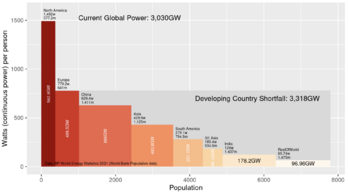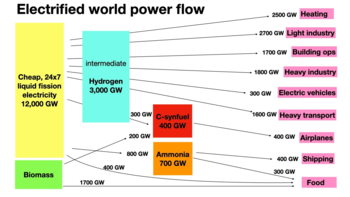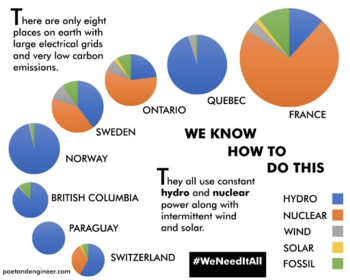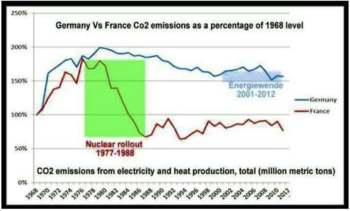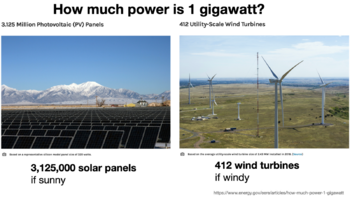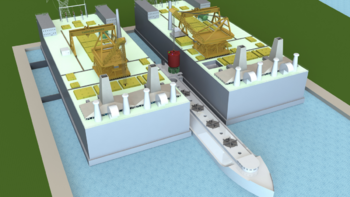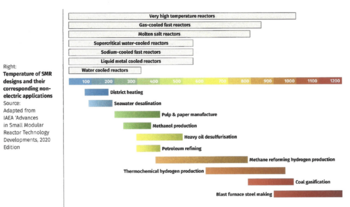Energy policy and global warming: Difference between revisions
| Line 29: | Line 29: | ||
Germany has made the biggest effort to go entirely with wind and solar power, starting in 2001, and hoping for a solution to the storage problem. Judged by their reduction in CO2 emissions, this effort has been a costly failure (Fig.5). Shutting down their nuclear plants left them dependent on Russian oil and gas and on their own coal resources. Whatever reductions in CO2 they achieved with wind and solar power, was largely offset by the added burning of fossil fuels. France went a different route, developing a standardized fleet of nuclear reactors, and converting almost their entire grid to nuclear in ten years. | Germany has made the biggest effort to go entirely with wind and solar power, starting in 2001, and hoping for a solution to the storage problem. Judged by their reduction in CO2 emissions, this effort has been a costly failure (Fig.5). Shutting down their nuclear plants left them dependent on Russian oil and gas and on their own coal resources. Whatever reductions in CO2 they achieved with wind and solar power, was largely offset by the added burning of fossil fuels. France went a different route, developing a standardized fleet of nuclear reactors, and converting almost their entire grid to nuclear in ten years. | ||
Even if we get the storage problem solved, a wind and solar only grid will be enormously expensive in land and mineral resources. See Figures 6 and 7 for a comparison of wind and | Even if we get the storage problem solved, a wind and solar only grid will be enormously expensive in land and mineral resources. See Figures 6 and 7 for a comparison of land requirements for wind, solar, and nuclear. | ||
== The Need for Immediate Action == | == The Need for Immediate Action == | ||
Revision as of 18:56, 3 June 2022
Climate scientists tell us that our consumption of fossil fuels is raising atmospheric CO2 levels, causing rapid global warming, and risking catastrophic climate change.[1] Most people now accept these conclusions, but there is still debate over whether the replacement for fossil fuels should include nuclear power. Many believe that nuclear power cannot be made safe and clean. See Nuclear power reconsidered for discussion of these concerns. Others believe that an energy policy that does not include nuclear is unrealistic. This article is a brief review of the options for decarbonizing our world.
The Magnitude of the Problem
Over millions of years, the Earth has developed an equilibrium between the carbon in the atmosphere and in the rocks and organic material on or near the surface. That equilibrium is now being radically altered by our consumption of fossil fuels. What seems to us like a slow change over decades, is a vertical spike in Fig.1. That spike is continuing to shoot upwards in spite of years of talk and negotiations among the world's nations, and failure to reach agreed on targets. The CO2 we put in the atmosphere now will last for centuries.[2] To minimize the risk of a catastrophic change in climate,[3] scientists are telling us we need to limit global warming to 2 degrees C.[4] That will require ten times more CO2 reduction than even the optimistic targets in current agreements. Clearly we need a new strategy.
The major contributors to our total CO2 emissions include heat for buildings and industrial processes, fuels for transportation, and electric power. Fig.2 shows our current total worldwide consumption of electric power, with each bar a different region on our planet. The height of the bar is the average per person, and the width is the population of each region, so the area of the bar is a good visualization of total consumption for a region. The developing countries are expected to increase their consumption, perhaps to the level of Europe, or half the level of North America. That will put the total worldwide average power at 6300 GW, or more than twice our current level.
A Plan for the Future
One vision for the future is using nuclear power to replace all fossil fuel power as in Fig.3. Abundant carbon-free power could be used to generate a mix of electric power and hydrogen appropriate for each sector of the economy. Home and office heating could be electrical or hydrogen piped through existing networks. District heating over short distances could be provided more efficiently by piping the reactor heat directly to nearby buildings. Industrial processes could also use heat from the reactors, especially the low-cost heat available during off hours. Energy for transportation could be electrical for light vehicles, and hydrogen for larger vehicles and rail. Synthetic fuel could be generated for airplanes and any other vehicles that truly need the compact energy of fossil fuels. Ocean shipping could be fueled with ammonia, one-third the energy density of fossil fuels.
A plan like that in Fig.3 may take decades to fully implement, but decarbonizing our electrical grids could be done in ten years, using current wind, solar, and nuclear technology. Several nations have already done it (Fig.4). Clean electricity alone will get us a path to zero carbon, and provide more time for development of clean fuel technologies.
The Problems with Wind and Solar Alone
- need for 100% fossil fuel backup - Fig.5
- use of land and mineral resources - Fig.6, 7
The major problem with wind and solar power is the intermittency of the weather. These sources, averaged over time, typically deliver 20 to 30% of their rated power, and can have very long periods with almost no power. A grid with a lot of wind and solar will need backup power able to deliver 100% of the demand from users for as many days as the weather might be bad. A wind and solar grid delivering an average of 3 GW power, will likely need 12 GW of peak wind and solar power, and some means of storing all the energy generated when the weather is good. Pumped hydropower is an option in a few favorable locations. Batteries are too expensive. Hydrogen may be possible, but the technology is still being developed. See Energy storage for more discussion of these options.
Germany has made the biggest effort to go entirely with wind and solar power, starting in 2001, and hoping for a solution to the storage problem. Judged by their reduction in CO2 emissions, this effort has been a costly failure (Fig.5). Shutting down their nuclear plants left them dependent on Russian oil and gas and on their own coal resources. Whatever reductions in CO2 they achieved with wind and solar power, was largely offset by the added burning of fossil fuels. France went a different route, developing a standardized fleet of nuclear reactors, and converting almost their entire grid to nuclear in ten years.
Even if we get the storage problem solved, a wind and solar only grid will be enormously expensive in land and mineral resources. See Figures 6 and 7 for a comparison of land requirements for wind, solar, and nuclear.
The Need for Immediate Action
Fig.8,9
Further Reading
Electrifying Our World Robert Hargraves' excellent overview of energy, the growth human civilization, and possible solutions to the current climate crisis.
Our World in Data has a section on Energy and Environment with nice interactive graphics.
World Nuclear Information Library a well-organized authoritative collection of information on nuclear power.
Notes and References
- ↑ IPCC Sixth Assessment Report - Impacts, Adaptation and Vulnerability
- ↑ Carbon is Forever, M.Inman, Nature 2008.
- ↑ One scary scenario involves a "positive feedback" mechanism in which the permafrost in the polar regions starts to thaw, releasing methane trapped for millions of years. The methane is 80 times more potent than CO2 as a greenhouse gas. This warms the permafrost further, and we could get a runaway condition with no escape, even if we cut our CO2 emissions to zero.
- ↑ UN Environment Emissions Gap Reports

